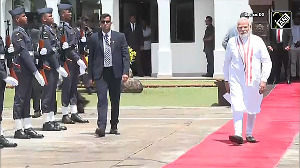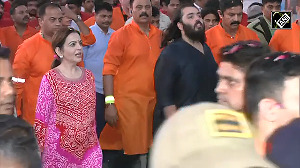Get Ahead presents a glimpse into the working life of airline cabin crew members. Here, 21-year-old Jet Airways air hostess Tanisha Thakkar* tells us all about her work hours, duties and life on the move:
It's 4:30 am on Tuesday, August 7, 2007 and I'm at the airport in a well-pressed uniform, shining shoes, and my hair in an elegant chignon. Why am I here at this hour? Because I'm on airport stand-by; if any of my colleagues cannot make it for the next domestic flight, I'll be travelling in his/ her place. Jet Airways doesn't take any chances.
I've been a stewardess with Jet for three years and running, ever since I was 18 years old. When I embarked upon my career I was doing strictly domestic sectors; now I am part of the international cabin crew. Today, however, I'm operating a domestic flight, or at least I thought so until I was pulled out for the Mumbai-London sector -- one of the crew members supposed to operate on that flight has taken ill.
I rush home from the airport to pack and prepare; I have to report back at the airport by 10:15 am. Short notice alright, but I've had a restful weekend -- I returned from London on Friday, Saturday and Sunday were holidays, Monday I was unassigned and here I am now on Tuesday morning, leaving for London. Flights are not usually so far apart, even for international crew, but this time around I was lucky.
I reach the airport for the second time that morning and start going through the routine -- cabin crew have to check in their baggage, go through security and report to the dispatch desk for a flight briefing. Since we are flying to London, we have to then fill in several forms -- immigration, customs declarations, baggage, sign-in sheets as Jet Airways crew and the special C-909 form, since we are operating to London.
Work positions for the flight are then filled in by our in-flight supervisor. With my experience, I've qualified to become an in-flight executive, one rung below the in-flight supervisor. I haven't accepted my promotion formally yet, since it will require me to go back to domestic flying for anywhere between six to eight months. However, when I do operate domestic flights, I am IFE on board, assisting the IFS in managing the crew. On international flights, I am a part of the regular crew, albeit exclusively catering to First Class.
The IFS for each flight allots each crew member to serve in the respective cabin zones of First Class, Premier Class and Economy. I'm part of what is known as 'dedicated First Class crew' -- stewards and stewardesses who are designated exclusively to First Class, because of our efficient and professional service on board. So naturally, I'll be serving First Class passengers, along with the IFS herself and one other designated crew member. The IFS then allots crew members to man the galleys for each of the three zones.
For this particular Mumbai-London flight I'm to do cabin service, while my colleague looks to the galley -- my job is to cater to the First Class passengers, while she will be in the galley heating food, getting drinks ready etc. If required, she will also assist me with service to the passengers in the cabin. This is what the galley crew on every flight does.
We then board the aircraft -- a massive Boeing 777-300. When you're appointed a crew member of any airline, you're trained to serve on a particular aircraft. In my case, I started off on a Boeing 737-800 for doestic flights, then moved on to the Airbus A340 and am currently on Jet Airways' most recent acquisition -- the 777. For each aircraft upgrade, we are sent back to training school, to learn about the plane we will be operating upon -- about the safety equipments and facilities on board, about handling emergencies etc.
Having boarded, the crew does a safety equipment check, which includes making sure that the doors can be secured effectively, that the oxygen bottles are operational in case of an emergency etc. The galley crew take a handover from the catering supervisor, who has stocked the galleys with food and drink for the flight. All of us prepare for on-ground services -- welcoming passengers on board, preparing drinks, towels, menu cards etc.
Next, our pilots get onto the aircraft and we offer them tea, coffee etc. Fifty minutes prior to departure, passengers start boarding. We secure the cabin, distribute welcome drinks etc and return to our jumpseats for take-off.
The load of passengers for this particular flight is light -- the 777 requires 15 crew members on board and has the following capacities for each zone:
~First Class: Eight seats, of which only two are occupied today.
~Premier Class: 30 seats, of which only six are occupied today.
~Economy: 274 seats, of which only 100 are occupied today.
So we have a load of 108 passengers on an aircraft capable of carrying 312 -- this is mainly because the travelling season of the year is over and on weekdays, families seem to prefer taking night flights (in the daytime, kids attend school or college).
We take off bang on time, at 12:45 pm. As soon as we are airborne, the crew start service -- we serve lunch to the passengers in our respective zones. We are on call for about an hour and a half, till all the passengers are done with their meals. We are as careful as possible when it comes to food, because many on board throw a fit when it comes to their meals. Sometimes a non-vegetarian passenger is upset to discover that all non-veg meals are over, at other times people order something from the menu of their own accord and end up disliking it -- we then have to replace their meal.
It is a trifle annoying that passengers have the choice of informing the airline of their meal choices when they book their tickets, but they fail to do so. Then on board they throw tantrums if they don't get what they like. This one time a gentleman seated in Premier Class actually threw the menu card in my face when I informed him that we had run short of what he desired to eat. Most of the time we have to take this behaviour in our stride, unless the situation gets out of hand. I merely smiled at him and informed another crew member to serve him for the rest of the flight and make sure that he was comfortable in all other respects. When he left the aircraft he was smiling -- our service recovery measures ensure passenger welfare and he was happy.
Getting back to my Mumbai-London flight -- once the passengers are done with their lunch, we serve the cockpit crew theirs and then eat some ourselves. We are then summoned by the IFS and are separated into two groups. One lot goes to the crew rest -- a section in the aircraft where we can sleep or rest in-between service -- while the other half continues with service.
About an hour and a half later, the resting crew return and all of us start off with our second service -- a movie snack at around 6 pm Mumbai time. Then the second lot of crew retires for an hour and a half. The third service has everyone on their toes once more, serving a hot snack (today it's kaathi rolls) before we land into London.
Prior to touchdown, we collect headsets, menu cards etc and hand out landing and immigration forms. On this Mumbai-London flight, we reach Heathrow Airport ten minutes early, at 17:30 pm London time. Once the aircraft has landed and come to a standstill we see all the passengers off and make sure that the aircraft galley, cabin and equipment are in decent condition to hand over to the next operating crew. Of course janitors clean it thoroughly after we check it out, but we can never leave it in a mess.
Now we collect our baggage, get into the crew coach waiting on the tarmac and head to the customs department, where the IFS submits the crew form authorising our stay in London. Then it's off to our hotel, 15 minutes away from the airport. There we have a short de-briefing and check in (each of us has our own room). I head to the hotel's crew lounge with a few colleagues, have dinner and turn in around 10 pm London time -- I have been awake and at work for 22 hours now.
The next morning I head to a few nearby shops and to lunch -- I have to report for duty back at the hotel this evening at 6:30 pm London time for the return flight home. The crew coach leaves shortly after and we are back at the airport, ready for the same routine all over again. We take off at 9:25 pm London time and land in Mumbai the next morning at 11 am India time. We have served through the night as before and the load on the returning flight is heavier -- 30 passengers in Premier Class and 160 in Economy.
I'm home by around 1:30 pm and I knock out for a few hours -- today is Thursday. I have the next two days off to spend with family and friends, after which I'll be heading to New York via London on Sunday morning. I also fly to Singapore and Jet Airways is opening up other international sectors left, right and centre -- I hope to fly to Brussels, Los Angeles and Toronto soon. I love my job -- Jet Airways is in my opinion the most professional Indian airline. But it's hard work and not everyone's cup of tea; while it sounds glamorous and is, in a lot of ways, it's physically exhausting. Sometimes your personal life is in shambles, but when you don your uniform you are a professional, smiling and welcoming passengers on board even though your mind is a million miles away. Sometimes passengers yell at you and turn nasty for things that are not your fault and you have to take it in your stride. I know I certainly do -- to get through these times is tough, but it's my job.
*Name changed to protect privacy.






 © 2025
© 2025